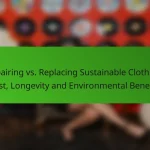Clothing swaps are an innovative way to promote sustainable fashion by allowing individuals to exchange garments, which reduces the demand for new clothing production. These events not only conserve resources but also enhance community engagement, encouraging social interaction and fostering a sense of belonging among participants.

How do clothing swaps promote sustainable fashion?
Clothing swaps promote sustainable fashion by facilitating the exchange of garments, thereby reducing the need for new clothing production. This practice not only conserves resources but also fosters community engagement and awareness about sustainable choices.
Reduction of textile waste
Clothing swaps significantly reduce textile waste by allowing individuals to give new life to garments they no longer wear. Instead of discarding clothes, participants can exchange them, which helps keep textiles out of landfills. This practice can divert thousands of tons of clothing from waste streams annually.
To maximize waste reduction, consider organizing swaps regularly and encouraging participants to bring quality items. This ensures that the exchanged clothing is desirable and usable, further minimizing waste.
Encouragement of circular economy
Clothing swaps are a practical example of a circular economy, where resources are reused and recycled rather than disposed of. By participating in swaps, individuals contribute to a system that values longevity and resourcefulness in fashion. This shift encourages brands and consumers alike to rethink their consumption habits.
To support this circular model, consider partnering with local businesses or organizations that promote sustainability. This collaboration can amplify the impact of clothing swaps and foster a community dedicated to eco-friendly practices.
Lower carbon footprint
Participating in clothing swaps can help lower the carbon footprint associated with fashion. By reusing garments, the demand for new clothing production decreases, which in turn reduces greenhouse gas emissions from manufacturing and transportation. This collective effort can lead to significant environmental benefits.
To further reduce your carbon footprint, choose to swap items that are gently used and in good condition. This ensures that the clothing remains functional and stylish, encouraging more people to participate in sustainable fashion practices.
Support for eco-friendly practices
Clothing swaps inherently support eco-friendly practices by promoting the reuse of materials and reducing the consumption of new resources. This approach aligns with sustainable fashion principles, encouraging participants to consider the environmental impact of their clothing choices.
To enhance the eco-friendly aspect of swaps, provide information on sustainable brands and practices during events. This education can empower participants to make more informed decisions about their fashion consumption beyond the swap itself.

What are the community benefits of clothing swaps?
Clothing swaps provide numerous community benefits by promoting social interaction, sustainability, and resource sharing. These events encourage individuals to connect with others while exchanging items, fostering a sense of belonging and environmental responsibility.
Strengthening local connections
Clothing swaps create opportunities for neighbors to meet and interact, strengthening local ties. Participants often discover shared interests and values, leading to lasting friendships and collaborations beyond the swap event.
By organizing clothing swaps in community centers or local parks, residents can engage with one another in a familiar and welcoming environment. This enhances community spirit and encourages ongoing participation in local initiatives.
Building inclusive communities
Clothing swaps are inherently inclusive, inviting individuals from diverse backgrounds to participate. They allow people to share their clothing and style, regardless of economic status, promoting equality and acceptance.
To ensure inclusivity, organizers can consider offering various clothing sizes and styles, catering to different demographics. This approach helps everyone feel valued and included, fostering a sense of community ownership.
Fostering collaboration and sharing
Clothing swaps encourage collaboration among participants, as they work together to curate and organize the event. This teamwork not only enhances the experience but also builds skills in event planning and community organizing.
Additionally, participants often share tips on sustainable fashion and personal style, creating a culture of knowledge exchange. This sharing of ideas can lead to further community projects focused on sustainability and responsible consumption.

How to organize a successful clothing swap?
To organize a successful clothing swap, start by planning logistics, setting clear guidelines, and effectively promoting the event. A well-structured swap not only encourages sustainable fashion but also fosters community engagement.
Choosing the right venue
Selecting an appropriate venue is crucial for the success of your clothing swap. Look for a space that is large enough to accommodate participants and their items, such as community centers, local parks, or even a spacious home. Ensure the venue has good lighting and accessibility for all attendees.
Consider the location’s convenience for your target audience. A central location with ample parking or public transport access can increase participation. If possible, choose a venue that aligns with sustainable practices, like one that uses eco-friendly materials or has recycling facilities.
Setting clear guidelines
Establishing clear guidelines helps participants know what to expect and ensures a smooth swapping process. Specify the types of items that can be swapped, such as clothing, accessories, or shoes, and set a limit on the number of items each person can bring to avoid overwhelming the event.
Communicate the condition requirements for items, emphasizing that only gently used or new items should be accepted. This maintains quality and encourages participants to be thoughtful about their contributions. Consider implementing a system for sorting items by size or category to make the swap more organized.
Promoting the event effectively
Effective promotion is key to attracting participants to your clothing swap. Utilize social media platforms, community boards, and local newsletters to spread the word. Create eye-catching graphics and clear messaging about the event’s date, location, and guidelines to generate interest.
Engage local businesses or influencers to help promote the event, possibly offering them a small space to showcase their products in exchange for their support. Consider creating an event page where attendees can RSVP, which helps you gauge interest and plan accordingly.

What are the costs associated with clothing swaps?
Clothing swaps can incur various costs that organizers need to consider to ensure a successful event. These expenses typically include venue rental fees, marketing expenses, and costs for refreshments and supplies.
Venue rental fees
Venue rental fees can vary significantly based on location, size, and amenities. For a small community swap, you might find spaces for as low as $50 to $200, while larger venues in urban areas could cost several hundred dollars. It’s essential to budget for this cost early, as it can impact the overall financial viability of the event.
Consider local community centers, libraries, or parks that may offer lower rates or even free options for non-profit events. Always check for any additional fees, such as insurance or cleaning deposits, that may apply.
Marketing expenses
Marketing expenses are crucial for attracting participants to your clothing swap. Costs can range from free social media promotions to several hundred dollars for printed flyers and ads. Utilize local community boards and online platforms to spread the word without overspending.
Consider creating a budget for promotional materials, such as posters or social media ads, and explore partnerships with local businesses to share costs. Engaging local influencers can also help increase visibility at minimal expense.
Refreshments and supplies
Providing refreshments and supplies can enhance the experience but also adds to the overall cost. Depending on the number of attendees, budgeting anywhere from $50 to $300 for snacks and drinks is reasonable. Simple options like water, coffee, and light snacks can keep costs manageable.
Additionally, think about supplies needed for the swap, such as hangers, tables, and signage. These items can often be borrowed from friends or local organizations, helping to minimize expenses while ensuring a smooth event.

What items are typically exchanged in clothing swaps?
Clothing swaps usually involve a variety of items, primarily focusing on gently used clothing, accessories, and shoes. Participants bring items they no longer need and exchange them for others, promoting sustainability and community engagement.
Clothing for all ages
Clothing swaps cater to all age groups, from infants to adults. Common items exchanged include shirts, pants, dresses, and outerwear. It’s essential to ensure that the clothing is in good condition, free from stains or significant wear, to maintain a positive swapping experience.
When participating, consider the seasonal relevance of the clothing. For example, bringing winter coats during colder months or summer dresses when the weather warms up can increase the likelihood of successful exchanges.
Accessories and shoes
Accessories such as bags, hats, scarves, and jewelry are popular items at clothing swaps. These smaller items can add variety to one’s wardrobe without taking up much space. Ensure that accessories are stylish and in good condition to attract interest from other participants.
Shoes are also frequently exchanged, ranging from casual footwear to formal options. It’s advisable to bring shoes that are clean and in wearable condition. Consider including a range of sizes to accommodate different participants, as this can enhance the overall success of the swap.










